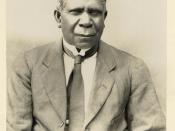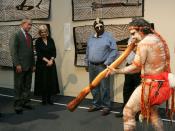Since the Federation until very recently, government policy relating to Aboriginal people has been designed and implemented by non-Aboriginal people. The common justification for most policies for Aborigines was that they were "for their own good". There have been policies of protection, assimilation, self-determination and reconciliation. It is now clear that none of these policies have actually made the condition of Australia's Indigenous people any better than it was prior to the federation.
When the six Australian colonies became a Federation in 1901, white Australia believed that the Aborigines were a dying race and the Constitution made only two references to them. Section 127 excluded Aborigines from the census (although heads of cattle were counted) and Section 51 (Part 26) gave power over Aborigines to the States rather than to the Federal Government. This was the situation until the referendum of 1967 when an overwhelming majority of Australians voted to include Aborigines in the census of their own country.
This extract from the Australian Constitution 1900 shows Section 127 before it was repealed in 1967.
In 1902, women in NSW were granted the right to vote, but this did not apply to Aboriginal women. And when compulsory voting was introduced in NSW in 1929, Aboriginal people were still excluded from voting under the Commonwealth Electoral Act 1918. In 1962, the Federal Government gave Aborigines the optional right to vote. State laws, however, still classified "natives" as "wards of the state" and as such they were denied the right to vote in State elections.
In 1881, George Thornton MLC was appointed the first NSW Protector of Aborigines. Under the NSW Aborigines Protection Act 1909-1943, this position was abolished and replaced by the Aborigines Protection Board. This became the NSW Aborigines Welfare Board in 1943. The Board administered government policy, dictating...


